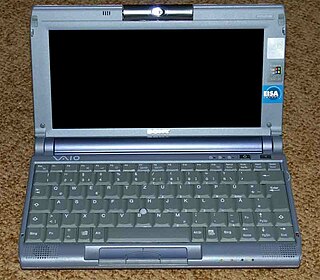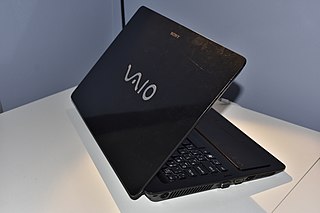
The Memory Stick is a removable flash memory card format, originally launched by Sony in late 1998. In addition to the original Memory Stick, this family includes the Memory Stick PRO, a revision that allows greater maximum storage capacity and faster file transfer speeds; Memory Stick Duo, a small-form-factor version of the Memory Stick ; the even smaller Memory Stick Micro (M2), and the Memory Stick PRO-HG, a high speed variant of the PRO to be used in high-definition video and still cameras.
VAIO Corporation is a Japanese manufacturer headquartered in Azumino, Nagano Prefecture that makes personal computers (laptops).
The Sony U series of subnotebook computers refers to two series of Sony products the PCG-U and the VGN-U. The later VGN-U were, at their release, the smallest independent computers running Windows XP and the most powerful high-end subnotebooks at the time. The VGN-U50 and VGN-U70P models are roughly the size of two DVD cases stacked on top of each other.

An ultra-mobile PC is a miniature version of a pen computer, a class of laptop whose specifications were launched by Microsoft and Intel in spring 2006. Sony had already made a first attempt in this direction in 2004 with its Vaio U series, which was only sold in Asia. UMPCs are generally smaller than subnotebooks, have a TFT display measuring (diagonally) about 12.7 to 17.8 centimetres, are operated like tablet PCs using a touchscreen or a stylus, and can also have a physical keyboard. There is no clear boundary between subnotebooks and ultra-mobile PCs, but UMPCs commonly have form factors other than the common clamshell laptop design, such as having small keys on either side of the screen, or having a slide-out keyboard.

The Samsung Q1 was a family of Ultra-Mobile PCs produced by Samsung with a 7" (18 cm) LCD and exists in several different versions with either Windows XP Tablet PC Edition or Windows Vista Home Premium
The Vaio VGN-TX2 was a subnotebook, or ultraportable, computer made by Sony.

Dell Vostro is a line of business-oriented laptop and desktop computers manufactured by Dell aimed at small businesses. From 2013–2015, the line was temporarily discontinued on some Dell websites but continued to be offered in other markets, such as Malaysia and India.

TravelMate is a series of business-oriented computer notebooks manufactured by Acer. Of the various notebook series Acer has offered, the TravelMate is designated as a lightweight business and professional computer built to withstand day-to-day activities. Travelmate laptops are well received by reviewers, often, however, they are faulted for a lack of visual appeal. The TravelMate name was previously used by Texas Instruments, which sold its mobile computing division to Acer in 1997. The TravelMate mainly competes against computers such as Dell's Latitude, HP's EliteBook and ProBook, Lenovo's ThinkPad and Toshiba's Portégé.

HP TouchSmart is a series of tablet PC laptops and touchscreen all-in-one desktop computers designed by HP. It features various Intel or AMD processors and runs Windows Vista or Windows 7 as standard.

The Sony Vaio P series is a range of ultraportable subnotebook computers launched in January 2009.

Sony Vaio FW is a discontinued series of notebook computers which were the first laptops ever to have a 1080p 16.4" 16:9 widescreen LCD. Higher end models in the series can support an integral Blu-ray Disc reader or writer. The laptop weighed 3.1 kg. The battery lasts up to 2 hours. In June 2009, the ATI Mobility Radeon HD 3650 was replaced by the ATI Mobility Radeon HD 4650 with the release of the FW 4xx series. Additionally, Sony also released a special model of this series apart from the signature series models (Model:VGN-FW590FFD). This model had a futuristic themed cover and came equipped with moderately high-end specifications for $1069.99 U.S. dollars. The VGN-FW590FFD model was also only available for purchase through Sony Style's website.
Sony has used the Z model naming scheme for its high-end ultraportable notebook computers since 2000. Unlike other Sony models, the Z has always been manufactured in Japan or in the United States for some models. Sony has stated that production of the Z series will cease at the end of 2012.

The Vaio X series is a line of high-end ultraportable notebook computers from Sony introduced in September 2009, claiming to be the world's lightest notebook, at 655 grams ( ). It features an 11.1", 16:9, 1366x768 LED-lit LCD screen with built-in webcam, 2GB of DDR2 RAM, a choice of 64, 128 or 256 GB SSD, Intel Atom Z540 1.86 GHz or Z550 2.00 GHz, WWAN.

The Vaio C1 PictureBook series is a series of subnotebooks from Sony's Vaio brand, branded 'Picturebook' for its webcam and video capture capabilities. It was first released on September 19, 1998, in Japan only.
The Sony Vaio 505 series was a line of ultraportable notebook computers from Sony's VAIO brand. The introduction date in the United States was July 24, 1998.

The Vaio F series is Sony's current multimedia and gaming orientated laptop. Launched in January 2010, it replaced the Sony Vaio FW series. Like the preceding model, it features a 16.4" screen, but with Full HD 1920x1080 resolution, 240 Hz refresh rate, and LED backlight. The model came in two choices, 2D or 3D models. The 3D model is included with 3D glasses.
Sony VAIO AR series was a range of high-end multimedia notebook computers from Sony introduced in June 2006 as the first laptop with integrated Blu-ray drive. It replaced the AX Series. It featured a 17" 16:10 widescreen LCD screen, with choice of 1440x900 or 1920x1200 resolutions. It was replaced by the AW series.
The Vaio Y series is a line of notebook computer from Sony introduced in January 2010. It is a netbook-inspired model designed for travel use: compared with the other 13.3" models in the Vaio range, the Y lacks an optical drive, and is heavier and cheaper than the premium Sony Vaio Z series, but lighter than the consumer-grade Sony Vaio S series, with better battery life than either, thanks to the use of CULV processors. The weight is 3.92lbs (1.78kg).
The Sony Vaio G series was a range of ultraportable subnotebook computers launched in 2007 with a 12.1" display.
The Sony Vaio VGX series was a series of living room PCs created for Sony's Vaio line that were released from 2005 until 2008. The VGX series was aimed at consumers who wanted the flexibility of able to watch TV and have the functionality of a computer at the comfort of their living room. All models came built-in with an HDMI port, VHF/UHF output, S-Video, Optical Audio port, and a variation of Microsoft Windows with Media Center installed.











